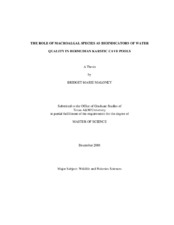| dc.description.abstract | Bermuda has one of the highest concentrations of cave systems of any country in
the world, but as the resident human population and tourism expand, this unique habitat
is becoming increasingly threatened by development and water pollution. A water
quality assessment was performed in six of Bermuda’s anchialine cave pools during
summer 2007. Vertical water profiles were collected at each site to determine
temperature, salinity, dissolved oxygen, and pH levels throughout the water column.
Each cave pool had its own unique hydrological patterns. Additionally, water samples
were collected at the surface and at the maximum depth to determine the concentration
of nitrate, nitrite, ammonium, phosphate, and urea in the water. Further samples were
collected to establish the fecal bacteria content in the surface waters. High nitrate levels
were measured in two of the cave pools, while unsafe bacterial levels were measured in
three pools.
In situ nutrient addition experiments were used to examine effects of nutrient
enrichment on algae naturally occurring in the six cave pool. Initial assessments of the
pools determined distribution of foliose species. Six algal species (Ulva sp., Caulerpa
mexicana, C. racemosa, C. sertularioides, Halymenia floresii, and Cryptonemia sp.)
inhabited multiple sites, but not all species occurred at all sites. Changes in the biomass
of individual plants were recorded for 6 to 12 days in response to N (nitrate), P
(phosphate), and NP additions. The effect of nutrient addition on increase in biomass
was significant over a 6 day period for Ulva sp. and H. floresii. Intermediate to no growth was seen in C. mexicana and Cryptonemia sp. C. mexicana exhibited both
increases and in biomass depending on the site. Cryptonemia sp. had low but positive
growth. A significant decrease in biomass occurred with C. racemosa and C.
sertularioides. Primary productivity was measured using the traditional light dark bottle
method. Differences in net productivity and respiration may explain why some plants
responded positively and other negatively to nutrient additions. Ulva sp. and H. floresii
showed potential as bioindicators for groundwater quality. | en |


